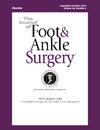Subtalar joint involvement with tibiotalocalcaneal intramedullary nail arthrodesis
IF 1.3
4区 医学
Q2 Medicine
引用次数: 0
Abstract
Tibiotalocalcaneal (TTC) fusion with an intramedullary nail (IMN) has been utilized for a myriad of indications in hindfoot and ankle reconstruction. However, some controversies remain on the optimal position of the hindfoot. Previous studies have reported on the potential medialization of the rearfoot during insertion of the IMN, but few studies have examined the potential affect on the subtalar joint. We performed the present cadaveric study in order to assess the involvement of a 12-mm IMN with the posterior facet of the calcaneus. A 3-mm guide wire (for a standard TTC IMN) was inserted in an anterograde fashion beginning within the central aspect of the tibial canal in 10 fresh-frozen below knee cadaver specimens. The subtalar joint of each specimen was exposed and images of the posterior facet were collected. Utilizing an open source Java image processing program (ImageJ/Fiji), we calculated a mean native calcaneal posterior facet of 4.6 cm2 with a post ream surface area of 3.6 cm2, resulting in a mean of 21.4% of the posterior facet occupied by an IMN in an anterograde fashion. In conclusion, a TTC IMN placed in optimal position within the ankle and tibia is likely to occupy, on average, a fifth of the calcaneal posterior facet. Though this does leave some possibility of a medial shift of the rearfoot complex, care must be taken to not violate the lateral calcaneal or talar wall.
胫骨-踝骨髓内钉关节置换术后的足下关节受累。
使用髓内钉(IMN)进行胫骨与踝关节(TTC)融合已被广泛应用于后足和踝关节的重建。然而,后足的最佳位置仍存在一些争议。以前的研究曾报道过在插入 IMN 的过程中后足可能会内侧化,但很少有研究探讨其对踝关节的潜在影响。我们进行了这项尸体研究,以评估 12 毫米 IMN 与小方块后方面的牵连。在 10 个新鲜冷冻的膝下尸体标本中,以逆行方式从胫骨管中央开始插入 3 毫米导丝(用于标准 TTC IMN)。暴露每个标本的胫骨下关节,收集后方切面的图像。利用开源 Java 图像处理程序(ImageJ/Fiji),我们计算出原生小腿骨后切面的平均面积为 4.6 平方厘米,铰接后表面积为 3.6 平方厘米,因此 IMN 以逆行方式占据的后切面平均面积为 21.4%。总之,在踝关节和胫骨的最佳位置放置的 TTC IMN 可能平均占据五分之一的小腿后侧切面。虽然这为后足复合体的内侧移位留下了一定的可能性,但必须注意不要侵犯小关节外侧或距骨壁。
本文章由计算机程序翻译,如有差异,请以英文原文为准。
求助全文
约1分钟内获得全文
求助全文
来源期刊

Journal of Foot & Ankle Surgery
ORTHOPEDICS-SURGERY
CiteScore
2.30
自引率
7.70%
发文量
234
审稿时长
29.8 weeks
期刊介绍:
The Journal of Foot & Ankle Surgery is the leading source for original, clinically-focused articles on the surgical and medical management of the foot and ankle. Each bi-monthly, peer-reviewed issue addresses relevant topics to the profession, such as: adult reconstruction of the forefoot; adult reconstruction of the hindfoot and ankle; diabetes; medicine/rheumatology; pediatrics; research; sports medicine; trauma; and tumors.
 求助内容:
求助内容: 应助结果提醒方式:
应助结果提醒方式:


